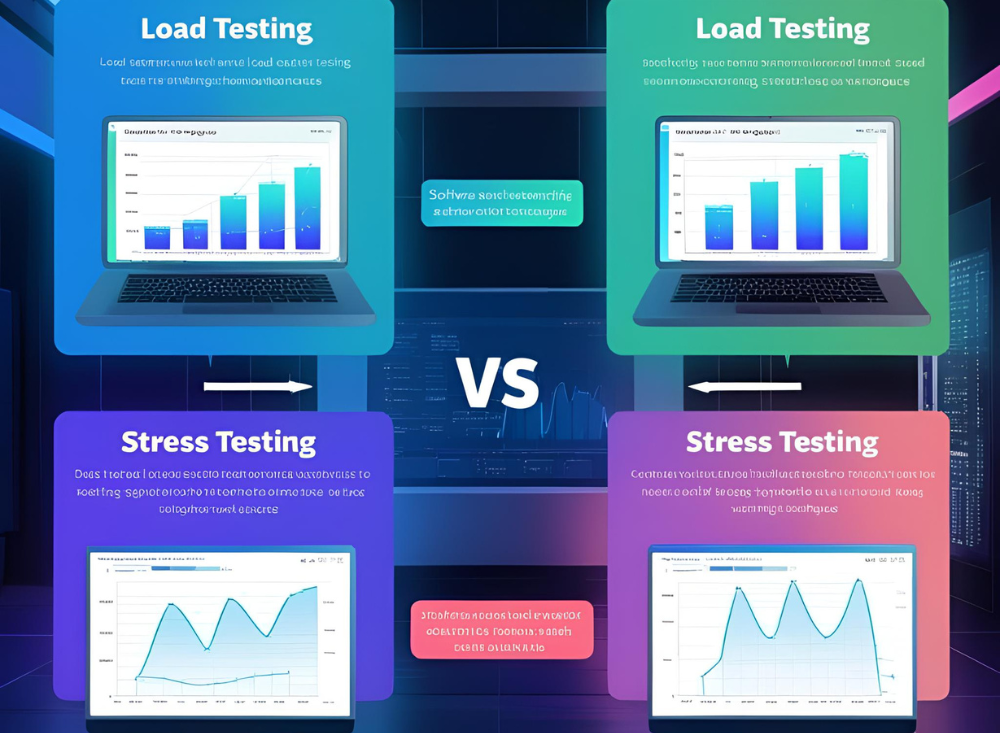
In the world of software development, ensuring that your application performs well under various conditions is critical for delivering a high-quality product. Two essential performance testing techniques are load testing and stress testing. While both aim to evaluate the performance of an application, they serve different purposes and are used in different scenarios. This article explores the differences between load testing and stress testing, their advantages, disadvantages, and how to decide which type of test you need.
What Is Load Testing?
Load testing is a performance testing technique that evaluates how an application behaves under expected user loads. The goal is to identify performance bottlenecks, such as slow response times or system crashes, and ensure the application can handle the anticipated number of users or transactions.
Key Characteristics of Load Testing
- Purpose: To measure performance under expected load conditions.
- Focus: Response time, throughput, and resource utilization.
- Scenario: Simulates real-world user loads to validate system behavior.
What Is Stress Testing?
Stress testing is a performance testing technique that evaluates how an application behaves under extreme or unfavorable conditions. The goal is to identify the breaking point of the system and ensure it can recover gracefully from failures.
Key Characteristics of Stress Testing
- Purpose: To measure performance under extreme conditions.
- Focus: System stability, error handling, and recovery.
- Scenario: Simulates conditions beyond normal operational capacity, such as high user loads or limited resources.
Advantages of Load Testing
- Identifies Performance Bottlenecks: Helps identify issues like slow response times or high resource usage.
- Ensures Scalability: Validates that the application can handle expected user loads.
- Improves User Experience: Ensures a smooth and responsive experience for users.
Advantages of Stress Testing
- Identifies Breaking Points: Determines the maximum capacity of the system.
- Ensures System Stability: Validates that the system can recover from failures.
- Improves Reliability: Ensures the application can handle unexpected spikes in traffic or resource constraints.
Disadvantages of Load Testing
- Limited Scope: Focuses only on expected load conditions, not extreme scenarios.
- Resource-Intensive: Requires significant time and resources to simulate realistic user loads.
- May Miss Edge Cases: Does not test the system’s behavior under extreme conditions.
Disadvantages of Stress Testing
- Complex Setup: Simulating extreme conditions can be challenging and time-consuming.
- Potential for System Damage: High stress levels may cause permanent damage to the system.
- Limited Real-World Relevance: Extreme conditions may not reflect real-world usage scenarios.
Load Testing vs Stress Testing
While both techniques aim to evaluate performance, they differ in their focus and objectives:
1.Purpose
- Load Testing: Measures performance under expected load conditions.
- Stress Testing: Measures performance under extreme or unfavorable conditions.
2.Focus
- Load Testing: Focuses on response time, throughput, and resource utilization.
- Stress Testing: Focuses on system stability, error handling, and recovery.
3.Scenario
- Load Testing: Simulates real-world user loads to validate system behavior.
- Stress Testing: Simulates conditions beyond normal operational capacity.
4.Outcome
- Load Testing: Identifies performance bottlenecks and ensures scalability.
- Stress Testing: Identifies breaking points and ensures system reliability.
So Which Type of Test Do You Need?
The type of test you need depends on your goals and the stage of development:
Use Load Testing When:
- You want to validate the application’s performance under expected user loads.
- You need to identify and resolve performance bottlenecks.
- You are preparing for a product launch or scaling your application.
Use Stress Testing When:
- You want to determine the breaking point of the system.
- You need to validate the system’s stability and recovery under extreme conditions.
- You are testing the application’s resilience to unexpected spikes in traffic or resource constraints.
Conclusion
Load testing and stress testing are both critical components of a comprehensive performance testing strategy. Load testing ensures your application can handle expected user loads, while stress testing validates its stability and reliability under extreme conditions. By understanding the differences and knowing when to use each technique, you can ensure your application performs well in all scenarios.
Incorporate both load testing and stress testing into your development process to deliver a high-quality, reliable, and scalable application. Start implementing these strategies today and take your performance testing efforts to the next level!